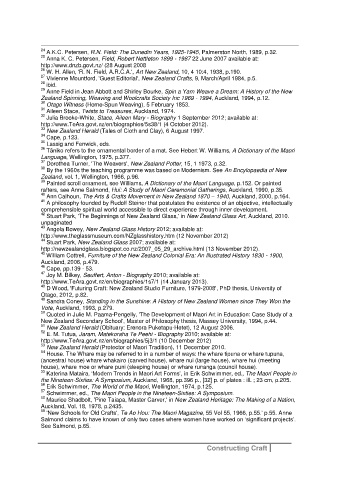Page 304 - Constructing Craft
P. 304
24 A.K.C. Petersen, R.N. Field: The Dunedin Years, 1925-1945, Palmerston North, 1989, p.32.
25
Anna K. C. Petersen, Field, Robert Nettleton 1899 - 1987 22 June 2007 available at:
http://www.dnzb.govt.nz/ (28 August 2008
26
W. H. Allen, 'R. N. Field, A.R.C.A.', Art New Zealand, 10, 4 10:4, 1938, p.190.
27 Vivienne Mountford, 'Guest Editorial', New Zealand Crafts, 9, March/April 1984, p.5.
28
ibid.
29
Anne Field in Jean Abbott and Shirley Bourke, Spin a Yarn Weave a Dream: A History of the New
Zealand Spinning, Weaving and Woolcrafts Society Inc 1969 - 1994, Auckland, 1994, p.12.
30 Otago Witness (Home-Spun Weaving), 5 February 1853.
31
Aileen Stace, Twists to Treasures, Auckland, 1974.
32
Julia Brooke-White, Stace, Aileen Mary - Biography 1 September 2012; available at:
http://www.TeAra.govt.nz/en/biographies/5s38/1 (4 October 2012).
33 New Zealand Herald (Tales of Cloth and Clay), 6 August 1997.
34
Cape, p.123.
35 Lassig and Fenwick, eds.
36
Tāniko refers to the ornamental border of a mat. See Hebert W. Williams, A Dictionary of the Maori
Language, Wellington, 1975, p.377.
37
Dorothea Turner, 'The Weavers', New Zealand Potter, 15, 1 1973, p.32.
38
By the 1960s the teaching programme was based on Modernism. See An Encylopaedia of New
Zealand, vol. 1, Wellington, 1966, p.96.
39
Painted scroll ornament, see Williams, A Dictionary of the Maori Language, p.152. Or painted
rafters, see Anne Salmond, Hui: A Study of Maori Ceremonial Gatherings, Auckland, 1990, p.35.
40 Ann Calhoun, The Arts & Crafts Movement in New Zealand 1870 – 1940, Auckland, 2000, p.164.
41
A philosophy founded by Rudolf Steiner that postulates the existence of an objective, intellectually
comprehensible spiritual world accessible to direct experience through inner development.
42
Stuart Park, 'The Beginnings of New Zealand Glass,' in New Zealand Glass Art, Auckland, 2010.
unpaginated
43
Angela Bowey, New Zealand Glass History 2012; available at:
http://www.theglassmuseum.com/NZglasshistory.htm (12 November 2012)
44
Stuart Park, New Zealand Glass 2007; available at:
http://newzealandglass.blogspot.co.nz/2007_05_29_archive.html (13 November 2012).
45
William Cottrell, Furniture of the New Zealand Colonial Era: An Illustrated History 1830 - 1900,
Auckland, 2006, p.479.
46
Cape, pp.139 - 53.
47
Joy M. Bilkey, Seuffert, Anton - Biography 2010; available at:
http://www.TeAra.govt.nz/en/biographies/1s7/1 (14 January 2013).
48
D Wood, 'Futuring Craft: New Zealand Studio Furniture, 1979-2008', PhD thesis, University of
Otago, 2012, p.82.
49
Sandra Coney, Standing in the Sunshine: A History of New Zealand Women since They Won the
Vote, Auckland, 1993, p.279.
50
Quoted in Julie M. Paama-Pengelly, 'The Development of Maori Art in Education: Case Study of a
New Zealand Secondary School', Master of Philosophy thesis, Massey University, 1994, p.44.
51
New Zealand Herald (Obituary: Erenora Puketapu-Hetet), 12 August 2006.
52
E. M. Tutua, Jaram, Matekoraha Te Peehi - Biography 2010; available at:
http://www.TeAra.govt.nz/en/biographies/5j3/1 (10 December 2012)
53
New Zealand Herald (Protector of Maori Tradition), 11 December 2010.
54
House. The Whare may be referred to in a number of ways: the whare tipuna or whare tupuna,
(ancestral house) whare whakairo (carved house), whare nui (large house), whare hui (meeting
house), whare moe or whare puni (sleeping house) or whare runanga (council house).
55
Katerina Mataira, ‘Modern Trends in Maori Art Forms’, in Erik Schwimmer, ed., The Maori People in
the Nineteen-Sixties: A Symposium, Auckland, 1968, pp.396 p., [32] p. of plates : ill. ; 23 cm, p.205.
56
Erik Schwimmer, The World of the Maori, Wellington, 1974, p.125.
57
Schwimmer, ed., The Maori People in the Nineteen-Sixties: A Symposium.
58
Maurice Shadbolt, 'Pine Taiapa, Master Carver,' in New Zealand Heritage: The Making of a Nation,
Auckland, Vol. 18, 1978, p.2435.
59
'New Schools for Old Crafts', Te Ao Hou: The Maori Magazine, 55 Vol 55, 1966, p.55.' p.55. Anne
Salmond claims to have known of only two cases where women have worked on ‘significant projects’.
See Salmond, p.65.
Constructing Craft

